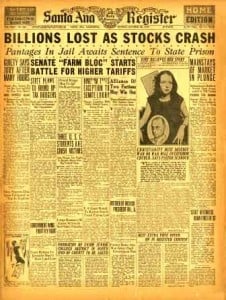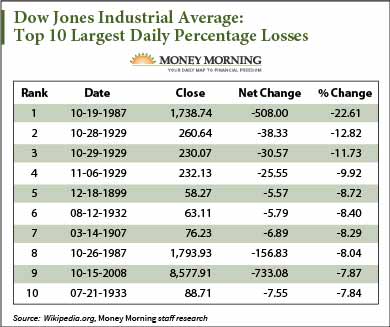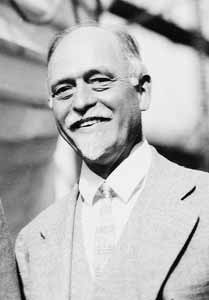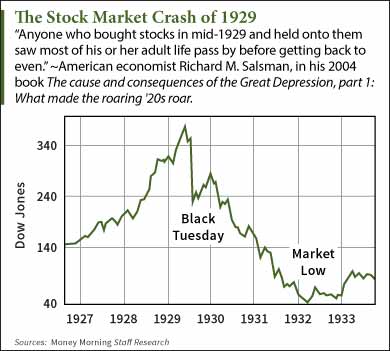
We begin our stock market crash history series with the most devastating in terms of duration and extent: the Stock Market Crash of 1929.
Black Tuesday, Oct. 29, 1929, marks the crescendo of this crash. On that day alone, the Dow dropped 12% (30 points) and 16 million stock shares exchanged hands - although for some investors, there were absolutely no buyers to sell to.
When the dust settled, more than $30 billion (roughly $350 billion in today's dollars) in wealth had been obliterated.
 But one thing that made the Stock Market Crash of 1929 truly devastating was that it drew out far longer than a single day...
But one thing that made the Stock Market Crash of 1929 truly devastating was that it drew out far longer than a single day...
In fact, the second-, third-, and fourth-worst stock market crashes (as measured by daily percentage losses) in Dow Jones Industrial Average history all occurred in 1929. Even the sixth- and 10th-worst crashes, on Aug. 12, 1932, and July 21, 1933, stem from volatility in the wake of the Wall Street Crash of 1929.
The Dow sank a total 48% from September to November 1929 and kicked off the 10-year-long Great Depression. It lost another 86% from April 1930 to July 1932 in the crash's aftermath.
Behind the Wall Street Crash of 1929 was a phenomenon that may be more familiar than you'd like...
What Caused the Stock Market Crash of 1929?
A speculative bubble - in the manufacturing industry - took hold in the 1920s.
In the first six months of 1926 alone, combined net profits of 536 manufacturing and trading companies increased 36.6%. The Dow Jones gained more than 20% between June and September 1929. The Roaring Twenties were riding high on encouraging share prices and the end of World War I. The stock market increased 10-fold in nine years.

"Stock prices have reached what looks like a permanently high plateau," popular American economist Irving Fisher told the public three days before the Stock Market Crash of 1929.
"Given the chance to go forward with the policies of the last eight years, we shall soon with the help of God, be in sight of the day when poverty will be banished from this nation," then-President Herbert Hoover said months before the crash. "We in America today are nearer to the final triumph over poverty than ever before in the history of any land."
His second-term presidential campaign in 1928 ran on the idea there would be "a chicken in every pot and a car in every garage."
People poured wealth into the market, even borrowing money to invest. In 1929 before the crash, two out of every five dollars a bank loaned were used to purchase stocks. More than $8.5 billion was out on loan - more than the entire amount of U.S. currency in circulation at the time.
But what (falsely) goes up must come down - and it did so, with theatrical tragedy...
The Grave Fallout of the Stock Market Crash of 1929
Legend has it famous American businessman Joseph "Joe" Kennedy stopped by a shoeshine shop in the winter of 1928 on his way to his Wall Street office. The shoeshine boy took Kennedy's tip money and remarked he was going to invest it in Hindenburg stock.
In years following the crash, Kennedy claimed he survived it because he'd predicted the whole thing. "You know it's time to sell when shoeshine boys give you stock tips. This bull market is over," he thought to himself. In 1929, Kennedy's fortune was around $4 million (equivalent to $54.9 million today). By 1935, it had increased to $180 million (equivalent to $3.1 billion today).
Indeed, the highly speculative stock prices began to decline after the market's peak on Sept. 3, 1929.
"We are reaping the natural fruit of the orgy of speculation in which millions of people have indulged," Albert Wiggin, president of Chase National Bank, said at the time. "It was inevitable, because of the tremendous increase in the number of stockholders in recent years, that the number of sellers would be greater than ever when the boom ended and selling took the place of buying."
 On Oct. 18, markets fell and a panic set in. In the last hours of trading on Oct. 24, "Black Thursday," the market lost 11% of its value at opening bell on record-breaking high volume. Banks and investment companies attempted to stem the bleeding by buying up huge blocks of shares, but another giant 13% drop hit the following "Black Monday," Oct. 28. Shares of mainstay companies like U.S. Steel and General Electric Co. (NYSE: GE) began to tumble. Brokers slept in their offices.
On Oct. 18, markets fell and a panic set in. In the last hours of trading on Oct. 24, "Black Thursday," the market lost 11% of its value at opening bell on record-breaking high volume. Banks and investment companies attempted to stem the bleeding by buying up huge blocks of shares, but another giant 13% drop hit the following "Black Monday," Oct. 28. Shares of mainstay companies like U.S. Steel and General Electric Co. (NYSE: GE) began to tumble. Brokers slept in their offices.
The next day, "Black Tuesday" (Oct. 29), the Dow slid 12%. The volume traded that day - a record 16 million shares and 15,000 miles of ticker tape - was not seen again for almost 40 years. Brokers committed suicide.
On Oct. 30, there was a small rebound, but after that the market fell every day until Nov. 13.
[epom key="ddec3ef33420ef7c9964a4695c349764" redirect="" sourceid="" imported="false"]
By the time the market bottomed out in 1932, the Dow had lost almost 90% of its value. By 1933, roughly half of all U.S. banks had failed. Unemployment approached 15 million people (30% of the workforce).
Stock prices wouldn't reach pre-crash levels for 25 years.
Of course, we could take a lesson in speculation from the Stock Market Crash of 1929. But then again, the wisdom was around even before the crash.
"There is nothing new in Wall Street," classic 1923 investing tome Reminiscences of a Stock Operator reads. "There can't be because speculation is as old as the hills. Whatever happens in the stock market today has happened before and will happen again."
Unheeded then, unheeded in 2008, and sure to go unheeded in the future.
The Stock Market Crash of 1929 was the first in our series of the greatest stock market crashes in U.S. history. Stay tuned to www.MoneyMorning.com for our next installment, and tweet the author @TaraKateClarke with any comments.
You might be losing money every day: Every investor is hard-wired to do three things that kill returns. Do you know how to avoid them? Find out what they are, plus the single-best investment strategy for maximum gains, in our free guide: Make Today the Start of Your Best Portfolio Ever...


